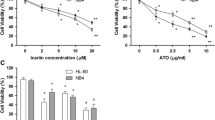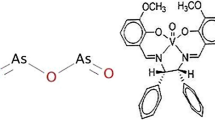Abstract
Purpose
Arsenic trioxide (As2O3), an inorganic arsenic compound, has recently been approved for the treatment of relapsed or refractory acute promyelocytic leukemia. However, systemic toxicity associated with As2O3 treatment remains a problem. Inorganic arsenic is detoxified in vivo by methylation reactions into organic arsenic compounds that are less toxic.
Methods and results
We investigated the antiproliferative and cytotoxic activity of dimethylarsinic acid (DMAA), an organic arsenic derivative and major metabolic by-product of As2O3, against a panel of eight leukemia and multiple myeloma cell lines. As2O3 was tested in comparison. In clonogenic assay, the average concentration of DMAA that suppressed cell colony growth by 50% was 0.5–1 mM, while for As2O3 it was on average 1–2 μM. At those concentrations DMAA and As2O3 had significantly less effect on colony growth of normal progenitor cells. Cytotoxic doses of DMAA and As2O3 in 3-day trypan blue dye exclusion assay experiments were similar to doses effective in clonogenic assay. Assessment of apoptosis by annexin V assay revealed a high rate of apoptosis in all cell lines treated with DMAA and As2O3, but significantly less effect on normal progenitor cells. DMAA, unlike As2O3, had no effect on the maturation of leukemic cells.
Conclusions
DMAA exerts differential antiproliferative and cytotoxic activity against leukemia and multiple myeloma cells, with no significant effect on normal progenitor cells. However, concentrations of DMAA needed to achieve such efficacy are up to 1000 times those of As2O3. Evaluation of novel organic arsenic that would combine the high efficacy of As2O3 and the low toxicity of DMAA is warranted.





Similar content being viewed by others
References
Vahter M, Concha G (2001) Role of metabolism in arsenic toxicity. Pharmacol Toxicol 89:1
Kenyon EM, Hughes MF (2001) A concise review of the toxicity and carcinogenicity of dimethylarsinic acid. Toxicology 160:227
US Environmental Protection Agency (1975) Initial scientific review of cacodylic acid (EPA 540/1-75-021). Criteria and Evaluation Division, Substitute Chemical Program
Crecelius EA (1977) Changes in the chemical speciation of arsenic following ingestion by man. Environ Health Perspect 19:147
Marafante E, Vahter M, Norin H, Envall J, Sandstrom M, Christakopoulos A, Ryhage R (1987) Biotransformation of dimethylarsinic acid in mouse, hamster and man. J Appl Toxicol 7:111
Buchet JP, Lauwerys R, Roels H (1981) Comparison of the urinary excretion of arsenic metabolites after a single oral dose of sodium arsenite, monomethylarsonate, or dimethylarsinate in man. Int Arch Occup Environ Health 48:71
Vega L, Styblo M, Patterson R, Cullen W, Wang C, Germolec D (2001) Differential effects of trivalent and pentavalent arsenicals on cell proliferation and cytokine secretion in normal human epidermal keratinocytes. Toxicol Appl Pharmacol 172:225
Romach EH, Zhao CQ, Del Razo LM, Cebrian ME, Waalkes MP (2000) Studies on the mechanisms of arsenic-induced self tolerance developed in liver epithelial cells through continuous low-level arsenite exposure. Toxicol Sci 54:500
Sordo M, Herrera LA, Ostrosky-Wegman P, Rojas E (2001) Cytotoxic and genotoxic effects of As, MMA, and DMA on leukocytes and stimulated human lymphocytes. Teratog Carcinog Mutagen 21:249
Ochi T, Nakajima F, Fukumori N (1998) Different effects of inorganic and dimethylated arsenic compounds on cell morphology, cytoskeletal organization, and DNA synthesis in cultured Chinese hamster V79 cells. Arch Toxicol 72:566
Sakurai T, Qu W, Sakurai MH, Waalkes MP (2002) A major human arsenic metabolite, dimethylarsinic acid, requires reduced glutathione to induce apoptosis. Chem Res Toxicol 15:629
Sakurai T, Kaise T, Matsubara C (1998) Inorganic and methylated arsenic compounds induce cell death in murine macrophages via different mechanisms. Chem Res Toxicol 11:273
Ochi T (1997) Arsenic compound-induced increases in glutathione levels in cultured Chinese hamster V79 cells and mechanisms associated with changes in gamma-glutamylcysteine synthetase activity, cystine uptake and utilization of cysteine. Arch Toxicol 71:730
Ochi T, Nakajima F, Sakurai T, Kaise T, Oya-Ohta Y (1996) Dimethylarsinic acid causes apoptosis in HL-60 cells via interaction with glutathione. Arch Toxicol 70:815
Abdullaev FI, Rivera-Luna R, Garcia-Carranca A, Ayala-Fierro F, Espinosa-Aguirre JJ (2001) Cytotoxic effect of three arsenic compounds in HeLa human tumor and bacterial cells, Mutat Res 493:31
Li Y, Sun X, Wang L, Zhou Z, Kang YJ (2002) Myocardial toxicity of arsenic trioxide in a mouse model, Cardiovasc Toxicol 2:63
Chiang CE, Luk HN, Wang TM, Ding PY (2002) Prolongation of cardiac repolarization by arsenic trioxide. Blood 100:2249
Waxman S, Anderson KC (2001) History of the development of arsenic derivatives in cancer therapy. Oncologist 6 [Suppl 2]:3
Novick SC, Warrell RP Jr (2000) Arsenicals in hematologic cancers. Semin Oncol 27:495
Strem Chemicals (1998) Dimethylarsinic acid. Material safety data sheet. Strem Chemicals, Newburyport, MA
Lallemand-Breitenbach V, Guillemin MC, Janin A, Daniel MT, Degos L, Kogan SC, Bishop JM, de The H (1999) Retinoic acid and arsenic synergize to eradicate leukemic cells in a mouse model of acute promyelocytic leukemia. J Exp Med 189:1043
Styblo M, Del Razo LM, Vega L, Germolec DR, LeCluyse EL, Hamilton GA, Reed W, Wang C, Cullen WR, Thomas DJ (2000) Comparative toxicity of trivalent and pentavalent inorganic and methylated arsenicals in rat and human cells. Arch Toxicol 74:289
Ochi T, Kaise T, Oya-Ohta Y (1994) Glutathione plays different roles in the induction of the cytotoxic effects of inorganic and organic arsenic compounds in cultured BALB/c 3T3 cells. Experientia 50:115
Author information
Authors and Affiliations
Corresponding author
Additional information
This work was supported in part by The Robert A. Welch Foundation.
Rights and permissions
About this article
Cite this article
Duzkale, H., Jilani, I., Orsolic, N. et al. In vitro activity of dimethylarsinic acid against human leukemia and multiple myeloma cell lines. Cancer Chemother Pharmacol 51, 427–432 (2003). https://doi.org/10.1007/s00280-003-0588-x
Received:
Accepted:
Published:
Issue Date:
DOI: https://doi.org/10.1007/s00280-003-0588-x




